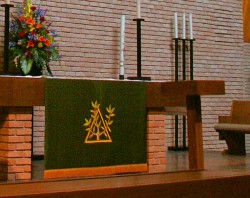(One of the goals of Brothers of John the Steadfast is to train the Brothers in good practice and theology. This article is one in a series that teaches about the liturgy.
These articles were initially intended to be put into bulletins or read during the service to educate the laity on the different parts of the service. They were therefore purposefully made short.
Notes on the Liturgy #10 — Alleluia Verse and other responses
 “Alleluia” means “praise the LORD.” It as an expression of joy that emphasizes victory in Christ. For this reason, it is common not to sing it during Lent, and to perhaps substitute a different verse in its place. This is a voluntary devotion to highlight the passion of our Lord. Notice in the different Divine Services of LSB, the Alleluia is combined with other words of Scripture. In LSB Setting 1 (p. 156), we sing the words of the disciples in John 6:68 “Lord, to whom shall we go? You have the words of eternal Life.” In Setting 4 (pg. 205), we sing John’s summation about Jesus’ miracles recorded in Jn 20:31, “These things are written that you may believe that Jesus is the Christ, the Son of God.” There are other verses taken from Scripture that may be used in accordance with a particular season of Sunday of the Church year (TLH listed them right in the order of service, and LW listed a unique verse every Sunday as part of the propers. These would typically be sung by the choir or spoken, but these two particular verses are used most frequently today for the common seasons.
“Alleluia” means “praise the LORD.” It as an expression of joy that emphasizes victory in Christ. For this reason, it is common not to sing it during Lent, and to perhaps substitute a different verse in its place. This is a voluntary devotion to highlight the passion of our Lord. Notice in the different Divine Services of LSB, the Alleluia is combined with other words of Scripture. In LSB Setting 1 (p. 156), we sing the words of the disciples in John 6:68 “Lord, to whom shall we go? You have the words of eternal Life.” In Setting 4 (pg. 205), we sing John’s summation about Jesus’ miracles recorded in Jn 20:31, “These things are written that you may believe that Jesus is the Christ, the Son of God.” There are other verses taken from Scripture that may be used in accordance with a particular season of Sunday of the Church year (TLH listed them right in the order of service, and LW listed a unique verse every Sunday as part of the propers. These would typically be sung by the choir or spoken, but these two particular verses are used most frequently today for the common seasons.
The Alleluia Verse thrusts our attention forward to the hearing of Jesus’ words, and originally served the mundane purpose of being “traveling music” in the early church as the procession of the Gospeltook place (see previous post on the readings). Thus, the Alleluia Verse is a tool to focus on and exalt the Gospel readings as well as adore the Lord of the Gospel. This is an important point. The liturgy has been formed by the church through the centuries. It is the culmination of the work of great theologians that the Lord has blessed His Church with. Lutherans have retained a liturgical form not because they love minutiae and tradition, but because the liturgy continues to point us beyond ourselves to the cross and the Gospel. The liturgy has been kept for the love of the Gospel.
Finally, here is a brief word on other responses to the Scripture readings. The phrase “Thanks be to God.” was used by early Christians to gain entrance into houses of worship. During periods of persecution the doorkeeper would accept this phrase and allow a person into the assembly. This phrase is retained in The Lutheran Hymnal and Lutheran Worship Divine Service I. Other responses like “Glory to you, O Lord” and “Praise to you, O Christ,” highlight the fact that we are not simply reading Scripture but that the God of the Bible is present with us in the Divine Service.
You may find all these by looking at our Regular Column on the Explanation of the Divine Service category or by using the shortcut https://steadfastlutherans.org/liturgy.
These notes were originally written in 2001 by Pastor David Oberdieck and have been edited. Thanks to Pastor Mathey for improvements to this segment.